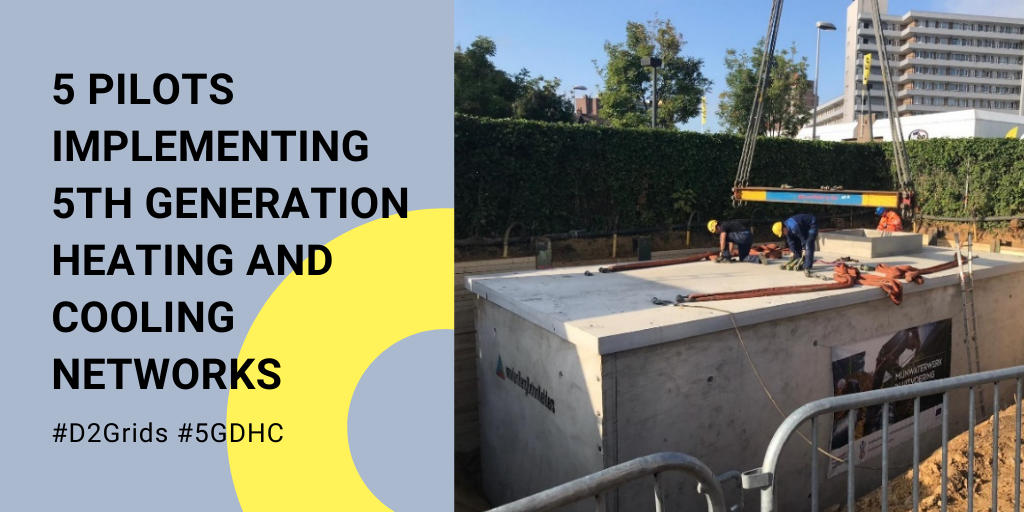While heating and cooling are responsible for half of Europe’s total energy consumption, 5th generation heating and cooling networks are the solutions to help us move towards decarbonized cities. D2GRIDS, a project funded by Interreg NWE, shapes the future of supplying our urban networks with geothermal energy and network flexibility. Discover the 5 pilot sites that since April 2019 are working to implement this innovative and low-temperature DHC system.
Brunssum – pilot of the island strategy
Mijnwater B.V. was founded by the municipality of Heerlen as a continuation of a successful experiment to see if abandoned coal mines could be used as a geothermal source for district heating and cooling systems. This resulted in Mijnwater becoming a prime example of 5th generation DHC.
The 5GDHC paradigm includes the flexibility to start up a new district system in a ‘bottom-up’ fashion, with small independent island systems that can afterwards grow organically and connect to form a full 5GDHC grid. Such a growth model is valuable, as we can adapt the deployment to the timing constraints of the local social, political, and financial situation.
Innovative island engineering
For the D2Grids project, the engineering plans in Brunssum include several new and innovative features. The main challenge is to start development with independent island solutions, that will later be part of a cluster in a new Brunssum heating and cooling network.
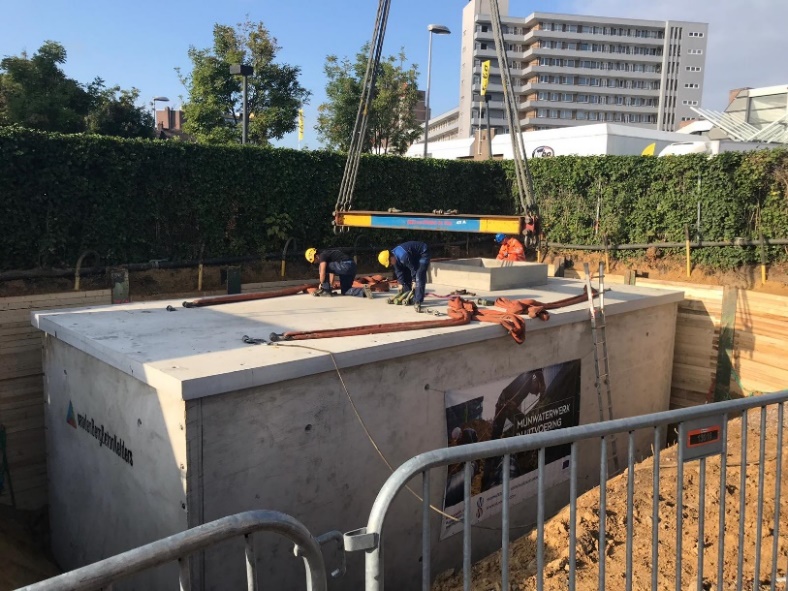
To build independent island systems, Mijnwater B.V. has further developed its existing technology, while adding several new ingredients. The existing grid of Heerlen already has small island-like systems, but all concentrated at a large building or a block of buildings. For D2Grids, this pattern will be generalised for a residential neighbourhood of semi-detached dwellings and apartment blocks.
The central ‘energy plant’ a prefab installation, installed in a prefab underground basement. It will supply sustainable energy to a total of 200 dwellings in Brunssum, divided over three small areas at Tarcisius, Oude Egge, and Pastoor Savelbergstraat. Thermal storage is provided from an aquifer doublet at the Tarcisius site. The prefab technical installation for this aquifer system is installed in a separate basement next to that of the energy plant. Another novelty is the use of temporary installations based on air-source heat pumps. This provides flexibility to give certain buildings the same service they will later get from the grid system before the grid infrastructure is locally available.
The island solution being built is naturally demand-driven, as it must serve a local area. The grid connections to the dwellings will deliver heating and cooling separately, using a 4-pipe system for the local area. Booster heat pumps provide domestic hot water with a buffer tank inside the buildings. In the longer run, this island will connect into the full 5GDHC system planned in Brunssum, that will profit from the large mine water volumes under the town. It will also connect to the industrial area of East Brunssum to provide cooling power while gathering waste heat.
For more information, please visit Mijnwater’s website here or read more about Mijnwater here. [Dutch]
Bochum, Germany – 5GDHC at the heart of a former Opel plant
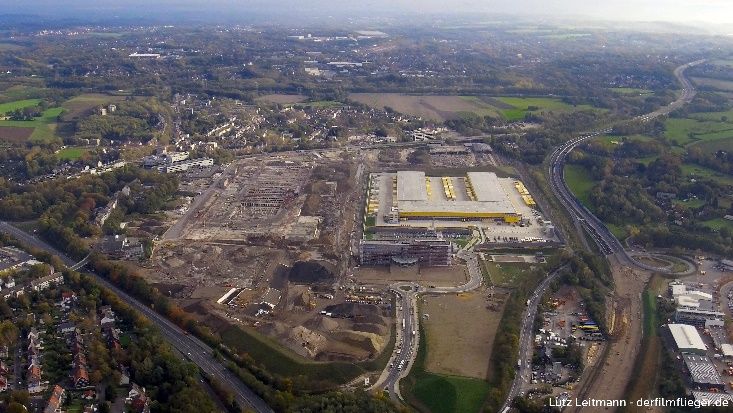
The Bochum pilot takes place at the former Opel plant in Bochum (Germany), called “Mark 51°7”. For the preparation and marketing of the land, Bochum Perspektive 2022 GmbH was founded to locate a broad mixture of newly built businesses and office buildings in the area. Due to the former mining activities on this site, there is a large mine water reservoir at a depth of several hundred meters, which can be used as energy storage and energy supply, with the support of a heat pump system. The mine is, so to speak, the backbone, the source and the storage for the heat and cold supply.
The pilot customer Faiveley is connected to the thermal mine water network via a substation with a local heat pump. This thermal network will be expanded later, with further substations (heating and cooling centre with heat pumps) to follow. The network is set up in such a way that the heating and cooling capacities can be made available to different customers at different temperatures.
Within D2Grids, the underground development of the Mark 51°7 site will be implemented. The mine building is to be developed hydraulically via two-directional boreholes. For this purpose, a well will be drilled into the 8th level at a depth of 816 m below the surface where a temperature of up to 36°C is projected. A second well will also be drilled into the 4th level at a depth of 334 m below ground with temperatures of about 19°C. Besides the implementation of two wells, a network connection to one pilot customer and the corresponding heat pump is part of the investment.
For more info, visit their website here or read more about the Bochum project here in Dutch.
Nottingham, UK – An innovative source of heat and cooling for Notthingham City Homes tenants
In Nottingham, the pilot aims at developing a new District Heating Network using mine water as a heat source to circ. 60 homes managed by Nottingham City Homes in the Crabtree Farm estate. The project could provide low carbon/cost heat to Nottingham City Homes tenants and contribute to the City’s ambition to be Carbon Neutral by 2028. It will also assess the potential for the technology to further roll out across the city and beyond.
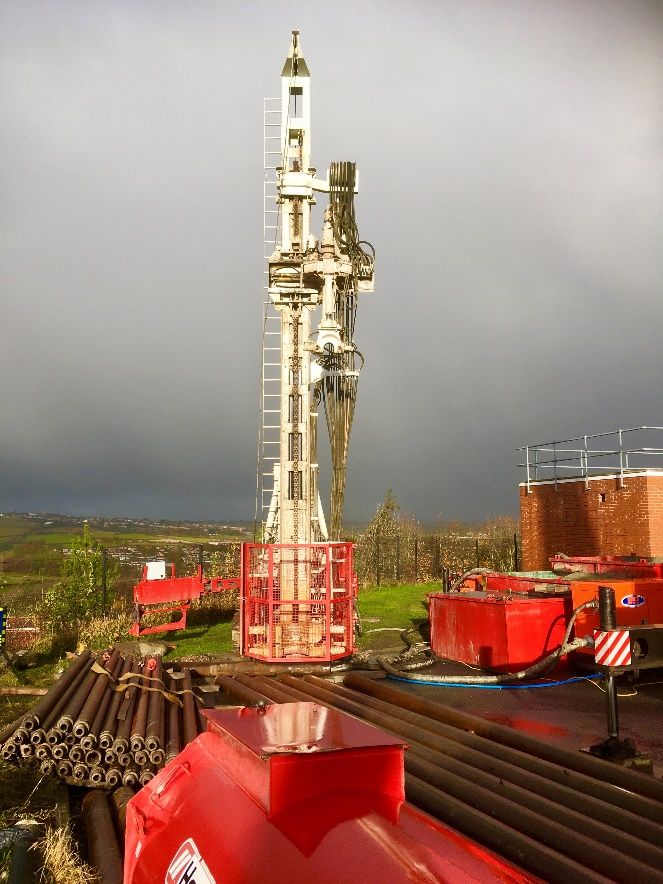
The network of flooded mines will provide a 15°C source of heat that will circulate in ‘ambient loop,’ i.e. a very low-temperature thermal network. Water will be brought to required temperatures by distributed heat pumps. True 5G systems have single hot and cold pipes with the bi-directional flow, rather than the traditional flow and return pipes for both heating and cooling. Nottingham will apply this set-up in Nottingham if there is sufficient cooling demand and economic benefit to justify any additional cost.
5G systems also allow the exchange of heat and cold within or between buildings across time, using thermal storage. If the hydrogeology is suitable and there is sufficient cooling demand to justify additional costs, the Nottingham pilot will also implement inter-seasonal heat and cold storage using mine blocks.
5G systems maximize the use of renewable energy through smart connections with the electricity grid. The pilot homes will interact smartly with solar PV and the grid, using excess/cheap electricity to replenish above ground thermal stores. There is also potential to replenish underground stores with heat generated using excess/low-cost electricity.
The objective of the Nottingham pilot is to eliminate all direct emissions from heating and cooling. Through improved housing efficiency, a very efficient heating and cooling system and flexible electricity demand, the project also aims to enable full electricity decarbonization.
For more information, please visit the project website here or read more about this project here in Dutch.
Paris Saclay, France – 5GDHC network : the keystone of EPA Paris-Saclay’s energy system
In France, the Land Planning Public Authority for the Paris-Saclay urban area is in charge of the development of one of a world-class technology and innovation cluster. The Paris Saclay District Heating and Cooling network is the cornerstone of this energy strategy.
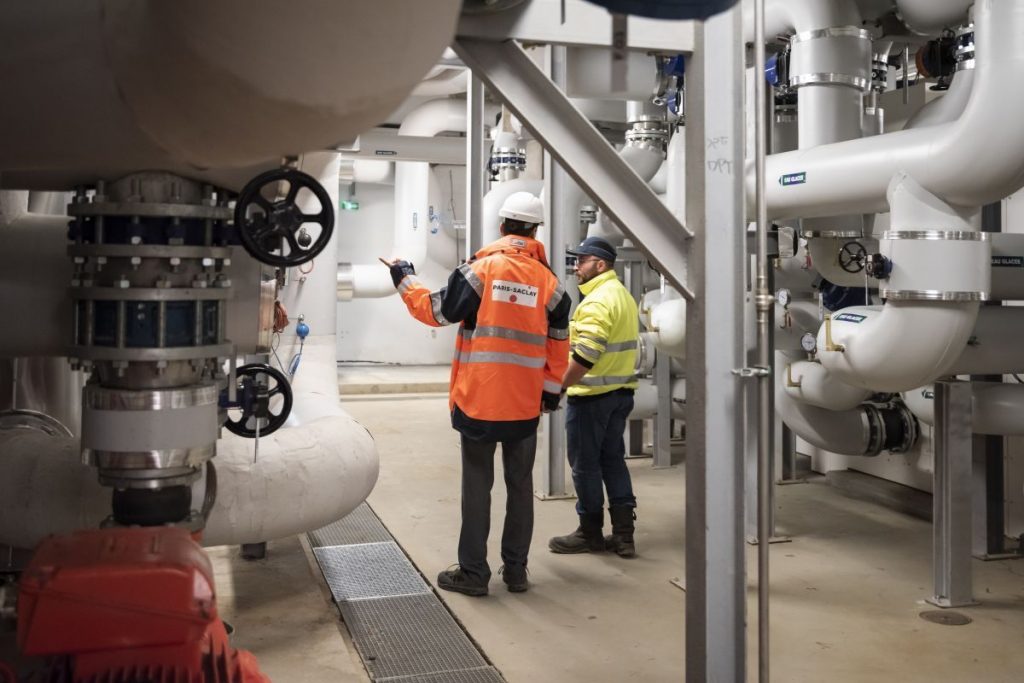
Designed around the largest temperate distribution loop in France, the Albien groundwater feeds the Paris-Saclay heat and cold exchange network, i.e. 700 billion cubic metres of water at an average temperature of 30°C. To harness this energy present in part of the Paris basin, boreholes have been drilled at a depth of 700 metres into the Albien aquifer: One pumping geothermal water the other returning it to the Albien aquifer after extracting its heat. Connected to the network, they will eventually supply renewable energy to all the buildings on the Paris-Saclay campus.
The grid now in operation on the urban campus. As a partner of the D2Grids project, Paris-Saclay will implement 5th generation district heating and cooling to its energy system. Thermal and advanced demand management systems will be tested to optimise its production and the energy consumption of buildings. Based on an IoT infrastructure deployed in parallel, the system will use artificial intelligence to learn about the energy behaviour of buildings and their users. In the short term, it will aim at increasing the share of renewable energy used while strengthening interactions with the smart grid on the urban campus. Largely powered by deep geothermal energy, it also makes it possible to exchange energy (hot and cold) between different building projects, contributing to a decrease in the cost of final energy.
The exchange network helps to reduce CO2 emissions by a factor of four by 2021. Combined with a smart grid, it will form the Paris-Saclay smart multi-energy network, a world first on this scale. Part of the grid’s electricity supply will be provided by self-consumption, via local production of renewable electricity. The recovery of local resources will also involve the recovery of residual energy from processes and data centres. Finally, studies are underway to assess the potential for energy recovery from organic matter: the production of biogas from private bio-waste, catering waste and agricultural residues could contribute to the energy self-sufficiency of the area.
You can read more about this project here [Dutch].
Glasgow, Scotland – 5GDHC at the core of the East End Glasgow’s regeneration initiative
Clyde Gateway is the largest regeneration initiative in Scotland based in the east end of Glasgow and focused on both sides of the River Clyde covering Glasgow City Council and South Lanarkshire Council areas.
It has developed an integrated energy strategy which concentrates its activity in Dalmarnock and Shawfield, two deprived communities now connected by the European funded SMART bridge to spur the transformation of these areas. Focus is given on developing locally resilient energy solutions that address fuel poverty, generate local income, and support the development and attract new businesses and jobs to the area.
Now halfway through its 20-year plan, Clyde Gateway has turned its focus to the key area of low carbon and renewable energy and reducing carbon emissions. As part of this strategy, the next step is to target even lower carbon emissions and the use of renewable energy by delivering 5th generation heating and cooling network through the D2Grids project.
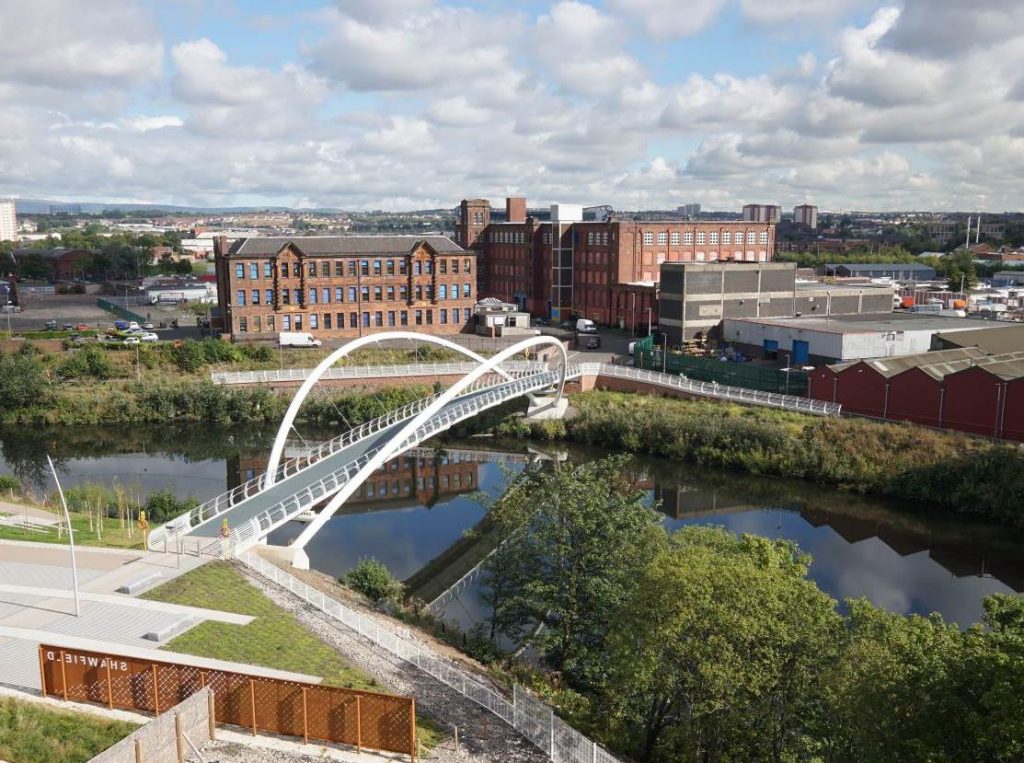
“Bridging the Energy Gap”
Building on the successful partnership with Scottish Water Horizons, Clyde Gateway aims to develop a low temperature, bi-directional ambient loop system based on 5GDHC principles, which will integrate with the treated effluent at the adjacent wastewater treatment works and use the SMART bridge to install district heating and cooling pipework to serve the masterplan areas. The £3m project will work with developers and end-user customers to deliver a range of decentralised heat pumps and associated thermal storage and smart digital management systems, to provide the technology to manage the heating and cooling needs within and between buildings on a modular basis with the capability of scaling up to serve the wider area.
Proposals include the supply of heating and cooling to the “Magenta” site in Shawfield with planning consent for 111,000m2 commercial development. The first building is completed, and plans for retrofitting are underway. The design solution to develop two additional buildings is part of the demonstrator project.
Clyde Gateway has completed the masterplan documents and technical specifications and is currently developing the business model along with project partners. The pilot has also commenced their market engagement towards procuring an Energy Partner both for the delivery of the demonstrator project and its long term management and operation. They hope to conclude the investment decision early in the New Year of 2021. “
For more information, please visite the project website here
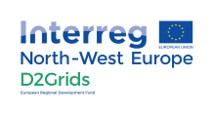
D2Grids is a project that aims to scale the 5th generation district heating and cooling networks (5G DHC) in Europe. At first at five test locations: Brunssum, Parijs-Saclay, Bochum, Glasgow and Nottingham. But also in Flanders. D2GRIDS (short for ‘demand driven grids’) is a project of Interreg NWE.
